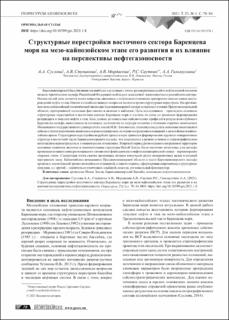| dc.contributor.author | Suslova, Anna A. | |
| dc.contributor.author | Stoupakova, Antonina V. | |
| dc.contributor.author | Mordasova, Alina V. | |
| dc.contributor.author | Sautkin, Roman S. | |
| dc.contributor.author | Gilmullina, Albina | |
| dc.date.accessioned | 2022-04-29T13:30:53Z | |
| dc.date.available | 2022-04-29T13:30:53Z | |
| dc.date.created | 2022-01-13T17:59:56Z | |
| dc.date.issued | 2021 | |
| dc.identifier.issn | 1608-5043 | |
| dc.identifier.uri | https://hdl.handle.net/11250/2993467 | |
| dc.description.abstract | Barents Sea basin is the most explored and studied by the regional and petroleum geologists on the Russian Arctic shelf and has approved gas reserves. However, there are many questions in the petroleum exploration, one of them is the structural reconstruction. During its geological evolution, Barents Sea shelf was influenced by the Pre-Novaya Zemlya structural zone that uplifted several times in Mesozoic and Cenozoic. The main goal of the research is to clarify the periods of structural reconstructions of the Eastern Barents shelf and its influence on the petroleum systems of the Barents Sea shelf. A database of regional seismic profiles and offshore borehole data collected over the past decade on the Petroleum Geology Department of the Lomonosov Moscow State University allows to define main unconformities and seismic sequences, to reconstruct the periods of subsidence and uplifts in Mesozoic and Cenozoic. The structural reconstructions on the Eastern Barents Sea in the Triassic-Jurassic boundary led to intensive uplifts and formation of the huge inversion swells, which is expressed in erosional truncation and stratigraphic unconformity in the Upper Triassic and Lower Jurassic strata. In the Jurassic period, tectonic subsidence reigned on the shelf, when the uplifts including the highs of Novaya Zemlya were partially flooded and regional clay seal and source rocks – Upper Jurassic «black clays» – deposited on the shelf. The next contraction phase manifested itself as a second impulse of the growth of inversion swells in the Late Jurassic-Early Cretaceous. Cenozoic uplift of the Pre-Novaya Zemlya structural zone and the entire Barents Sea shelf led to significant erosion of the Mesozoic sediments, on the one hand, forming modern structural traps, and on the other, significantly destroying the Albian, once regional seal. | en_US |
| dc.language.iso | eng | en_US |
| dc.publisher | Kazanskij gosudarstvennyj universitet | en_US |
| dc.rights | Navngivelse 4.0 Internasjonal | * |
| dc.rights.uri | http://creativecommons.org/licenses/by/4.0/deed.no | * |
| dc.title | Structural reconstructions of the Eastern Barents Sea at Meso-Tertiary evolution and influence on petroleum potential | en_US |
| dc.type | Journal article | en_US |
| dc.type | Peer reviewed | en_US |
| dc.description.version | publishedVersion | en_US |
| dc.rights.holder | Copyright 2021 the authors | en_US |
| cristin.ispublished | true | |
| cristin.fulltext | original | |
| cristin.qualitycode | 2 | |
| dc.identifier.doi | 10.18599/GRS.2021.1.8 | |
| dc.identifier.cristin | 1980765 | |
| dc.source.journal | Georesursy | en_US |
| dc.source.pagenumber | 78-84 | en_US |
| dc.identifier.citation | Georesursy. 2021, 23 (1), 78-84. | en_US |
| dc.source.volume | 23 | en_US |
| dc.source.issue | 1 | en_US |

